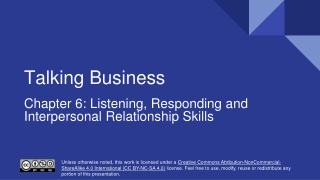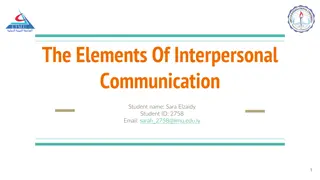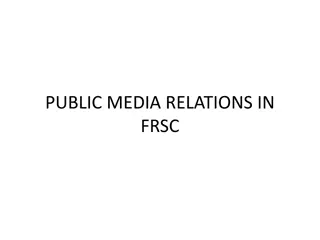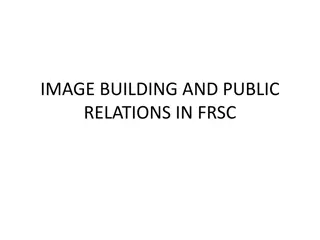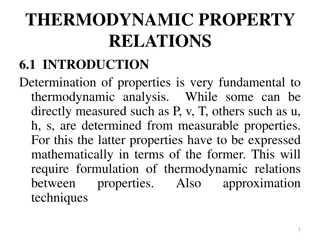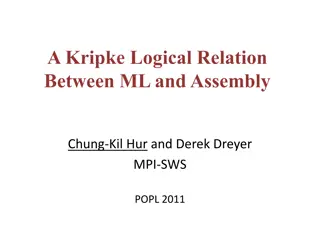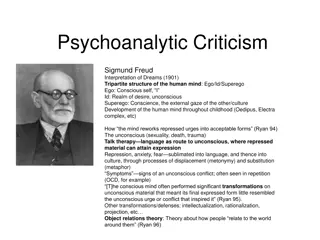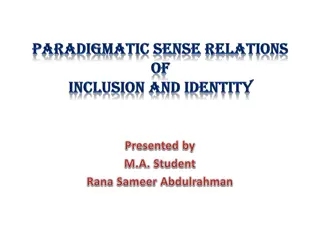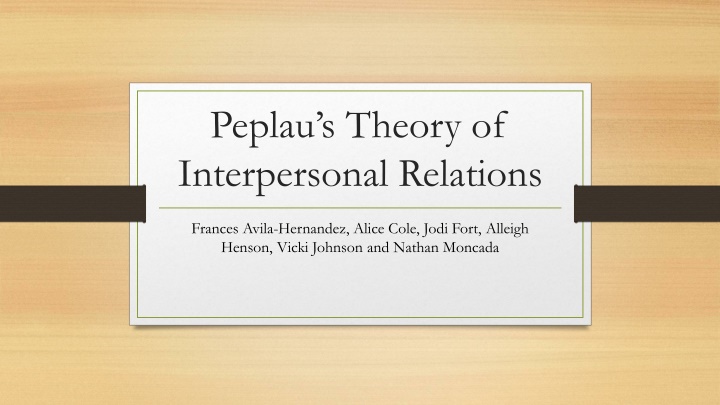
Peplau's Theory of Interpersonal Relations in Nursing
Explore Peplau's Theory of Interpersonal Relations in nursing, emphasizing the importance of the nurse-client relationship and the four phases of the theory. Learn how to apply this theory in nursing practice through a structured approach involving identification, education, behavior modification, and termination of the nurse-client relationship.
Download Presentation

Please find below an Image/Link to download the presentation.
The content on the website is provided AS IS for your information and personal use only. It may not be sold, licensed, or shared on other websites without obtaining consent from the author. If you encounter any issues during the download, it is possible that the publisher has removed the file from their server.
You are allowed to download the files provided on this website for personal or commercial use, subject to the condition that they are used lawfully. All files are the property of their respective owners.
The content on the website is provided AS IS for your information and personal use only. It may not be sold, licensed, or shared on other websites without obtaining consent from the author.
E N D
Presentation Transcript
Peplaus Theory of Interpersonal Relations Frances Avila-Hernandez, Alice Cole, Jodi Fort, Alleigh Henson, Vicki Johnson and Nathan Moncada
Hildegard Peplau and The Theory of Interpersonal Relations The simplest understanding of this nursing theory is that it is all about the nurse-client relationship. It involves both the nurse and the client working to understand their own behavior (D Antionio, Beeber, Sills, and Naegle, 2014). It focuses on creating a partnership instead of the patient just receiving treatment and the nurse simply following an order from a doctor. In Peplau s theory, nursing is defined as an interpersonal, therapeutic process that takes place when professions engage in therapeutic relationship with people who are in need of health services (Hagerty, Samuels, Norcini-Pala, & Gigliotti, 2017). The idea is that the nurse will understand the client enough to understand what their limits may be, and how they can still have growth despite them
Theory of Interpersonal Relations Four Components of Theory or Metaparadigm Person Environment Health Nursing Four Phases of Theory Phase 1: Orientation This is where the patient seeks help for their problem Phase 2: Identification This involves the nurse using education in order to build trust with the patient Phase 3: Exploitation This stage is all about behavior modification. Helping the patient understand what they need to change in order to meet their new needs Phase 4: Termination This is the end of the nurse- client relationship. This means the patient can now self- manage their main issues of concern and is able to be released from care
Nursing Practice Using Peplau s Theory Example in Practice: In Theory: First, we must identify what exactly our client is asking for help with. This means concerns and behaviors Nurse must act professionally, ethically and emotional sound and nonjudgmental for trust to be gained After we know what issues are bothering our client, we can then start to educate them about what is concerning them, and we do so by using evidence-based practice Behavior modifications means understanding triggers that the person is receiving and finding ways to help them around it. This is also when the nurse-client relationship will start to set goals! Finally comes the termination phase, this is when we know the patient is now self-manageable Client is concerned because his A1C is not decreasing and he may have to go on insulin. The nurse should refrain from lifestyle judgements and instead take this as an opportunity to educate the client on the proper diet and exercise routine that may help to lower their A1C lab tests. Talk about why the client has a problem making healthy choices, are they depressed? Do they not have access to healthy choices? Is money an issues? Set realistic goals! Make it a goal to only eat out 2 times in a week and 3 times a week to go on a walk through the neighborhood. When the nurse sees a change in the patients ability to modify their diet and stick to an exercise program, they will terminate the relationship at an appropriate time. (Gilkes, 2019)
Person Person refers to the patient and may include family members or community groups depending on the situation. It includes a knowledge of the physical, spiritual, psychological and cultural aspects of the patients. It also include self- care, choices and goals. All parts of the person are being assessed to make sure we are caring for the whole person and not just the condition or illness. Self-care is equally important because it demonstrates a balance that can relieve stress and is important in the healing process. Self-care can include prayer, meditation and exercise. Interpersonal Relationship- formed when two individuals share communication and have a common goal. The nurse does more than carry out an order, and the patient is just not the recipient of care. They work together on the shared goal.(Hagerty, 2017).
Environment Environment includes internal and external factors, the surroundings and where the care is being received. It includes marital status, social support, access to healthcare and pets. Environment is not a behavior, but it has an impact on patient care. All parts of the environment are assessed to see if any additional concerns need to be addressed during the patient s hospital stay. The nurse needs to be sure the patient s environment allows for safety and healing. Florence Nightingale s Environmental Theory defined Nursing as the act of utilizing the environment of the patient to assist him in his recovery. Florence Nightingale proved this theory during the Crimean War by implementing a sanitary environment. As a result, a decrease in the mortality rate was noticed .(Gonzalo, 2019)
Nursing Health Physical : the condition of the body Emotional : the condition of the mind Intellectual : the level of understanding Spiritual : the inner belief and strength Social Dimensions : the support system and influences Assessing : gather information Critical thinking : purposeful, logical examination of data Community : everyone Providing care : action Teaching : educating Leading : inspire According to Jean Watson nursing is not just about medication and physiological diagnosis, it is holistic : physical, mental, and spiritual. We must establish relationships, treating and educating to provide health, healing and caring for holistic wellness. (Sitzman & Watson, 2018) Peplau thought of health as symbol for the patient making progress with their personality and other human traits, both personal and community based.
Evidence Based Practice: part 1 Peplau s Theory of Interpersonal Relations was investigated via HCAHPS (Consumer Assessment of Healthcare Providers and Hospital Systems) surveys that were sent to patients after discharge. The surveys included demographic information such as age, gender, and length of hospital stay. The surveys were generated and sent to the patient by mail up to 6 weeks after discharge and all responses were kept confidential. Four campuses participated in the investigation that surveyed patients on 16 items relating to patient experience. The purpose of this investigation was to gather information regarding the three phases of Peplau s theory and their effects on patient care and satisfaction
Part 1: Continued The results clearly show a positive effect on patient satisfaction through the orientation phase of Peplau s theory of interpersonal relations. Through results of HCAHPS surveys, patients viewed the nurse as caring, trustworthy, and responsible as a result of correct application of the orientation phase and had an easier transition to the working phase because of the respect and trust that was built through proper communication and listening to the patient. Careful, nondirective listening was extremely important, and it is in the orientation phase that the nurse s behavior signals a pattern of receptivity and interest in the patient s concerns or fails in this regard (Peplau, 1992). Nurses who did not communicate properly, ask patient questions regarding their current and past medical history, and showed a lack of interest in the patient were noted as selfish, arrogant, and distant, which caused the patient to feel like they were in limbo and kept out of the nursing care plan (Forchuk, Westwell, Martin, Azzapardi, Kosterewa-Tolman, and Hux, 1998). Nursing care is noted as the most influential factor (Otani, Herrmann, and Kurz, 2011) in the HCAHPS survey and throughout healthcare, in general. This survey proved that the three-factor Peplau model was more accurate than the two-factor model that was originally implemented. It was also proven through this survey that the orientation phase of Peplau s theory of interpersonal relations allows the nurse to build a trustworthy and respectful relationship with the patient that ultimately leads to higher patient satisfaction.
Evidence Based Practice: Part 2 Effective communication in nursing is anchor by strong interpersonal relationships. Use of effective interpersonal communication strategies by nurses in both personal and professional settings, may reduce stress, promote wellness, and therefore, improve overall quality of life, (Vertino, 2014). An example would be, patient education; is a powerful tool and an effective interpersonal communication strategy use in the line of nursing. Whether addressing patient s concerns, or educating on medication safety, or simply discharge education; research has shown this nursing intervention to have long-term benefits: improving health outcomes, enhancing the patient experience, improving patient satisfaction, and reducing avoidable hospital readmission.
Part 2: Continued Research have also shown that if the patient has better understanding of the teaching, this will lead to quality self-management and greater compliance to the care plan. One effective way of patient education is by using the teach-back method which closes the loop on the nurse-patient communication gap by proactively enhancing patient comprehension. Nurses can assess the patient s understanding of the teaching by asking the patent to explain the information in his or her own words. It is during this time that a nurse can evaluate the patient s knowledge of the information being provided to them. It also gives the nurse the opportunity to either clarify or modify the teaching.
Evidence Based Practice: Part 3 Patient care depends greatly on the relationship between the patient and nurse. During the orientation phase patients begin to trust their healthcare team. We as nurses spend more time with the patient than any other person involved in the care team. If the patient does not trust their nurse, they could withhold information that could be important and result in a negative patient outcome. As evidence practice shows, patients who rated their overall experiences as most positive were significantly more likely to have had higher numbers of nurses per patient days (Jha, Orav, Zheng, & Epstein, 2008).
Quick Review Peplau s theory defines nursing as a therapeutic process that involves communication between the nurse and patient. This theory is most used in the Mental Health Nursing environment but can truly be used in all areas of healthcare. Evidence based practice taken from HCAHPS surveys has proven that by using this theory, patients experience an overall higher satisfaction rating with their healthcare experience. Evidence based practice has shown that by using Peplau s theory and incorporating good patient education, we can see an increase in patient compliance. Evidence based practice has shown that patients are less likely to withhold useful information to the nurses that they trust; which makes the orientation phase of Peplau s theory especially important to the overall well being of the patient.
D Antionio, P, Beeber, L, Sills, G & Naegle, M 2014, The future in the past: Hildegard Peplau and interpersonal relations in nursing , https://onlinelibrary.wiley.com/doi/full/10.1111/nin.12056 Hagerty, T. A., Samuels, W., Norcini-Pala, A., & Gigliotti, E. (2017, April). Peplau's Theory of Interpersonal Relations: An Alternate Factor Structure for Patient Experience Data? Retrieved December 2019, from https://www.ncbi.nlm.nih.gov/pmc/articles/PMC5831243/. Gilkes, M. (2019). Peplau's Theory A Nurse/Patient Collaboration. [online] Ausmed.com. Available at: https://www.ausmed.com/cpd/articles/peplaus-theory Sitzman, K., & Watson, J. (2018). Caring science, mindful practice : implementing Watson's human caring theory. Second edition. New York, NY: Springer Publishing Company, LLC. Peplau HE. Interpersonal relations: A theoretical framework for application in nursing practice. Nursing Science Quarterly. 1992;5:13 18. [PubMed] [Google Scholar] Forchuk C, Westwell J, Martin M, Azzapardi WB, Kosterewa-Tolman D, Hux M. Factors influencing movement of chronic psychiatric patients from the orientation to the working phase of the nurse-client relationship on an inpatient unit. Perspectives in Psychiatric Care. 1998;34:36 44. [PubMed] [Google Scholar] Otani K, Herrmann PA, Kurz RS. Improving patient satisfaction in hospital care settings. Health Services Management Research. 2011;24:163 169. [PubMed] [Google Sc] Vertino, K.A. (2014). Effective interpersonal communication: a practice guide to improve your life. Vol (19). Retrieved from, http://ojin.nursingworld.org/. Hagerty, T. A., Samuels, W., Norcini-Pala, A., Giggliotti, E. (2018). Peplaus s theory of interpersonal relations: An alternate factor structure for patient experience data? 30(2). doi: 10.1177/0894318417693286. Retrieved from, https://www.ncbi.nlm.nih.gov/pmc/articles/PMC5831243/#R1. Jha, A. K., Orav, E. J., Zheng, J., Epstein, A. M. (2008). Patients perceptions of hospital care in the United States. New England Journal of Medicine, 359, 1921-1931. References Gonzalo, Angelo. (2019). Florence Nightingale: Environmental Theory. Retrieved November 21, 2019 from https://nurseslabs.com/florence-nightingale. Grand Canyon University (Ed). (2018). Dynamics in nursing: Art & science of professional practice. Retrieved November 21, 2019 from https://lc.gcumedia.com/nrs430v/dynamics-in- nursing-art-and-science-of-professional-practice/v1.1/

